
 |
![]()
1940 - 1949
With Cal and Washington finishing within a deck of each other after four miles at the 1939 IRA, and both crews smashing the course record, the stage was set for this powerful rivalry to blossom into the next decade. Both Al Ulbrickson and Ky Ebright were confident of their chances as the thirties gave way to the forties.
And well they should have been. This decade will be remembered for some of the fastest, most dominant crews ever produced by the two universities. In fact, it is the only recorded time that both schools would win gold medals in the same Olympics. Unfortunately it is also a decade marked by war - a war that would impact the lives of everyone on campus - and in the end begin a new era in collegiate athletics, and the sport of rowing.
![]()
1940
With renewed focus and a powerful sophomore class, turnout in the fall was spirited. Competition was wide open for the varsity and the junior varsity shells, and the afternoon workouts reflected it. After a pause in December, the crews were back on the water in January as Ulbrickson began to find the men that would fill his eights in the coming weeks.
By April, he had settled on a sophomore dominated varsity boat, with Captain Paul Soules and coxswain Fred Colbert the only seniors in the boat. Ebright, on the other hand, was having trouble finding the line up he wanted - the day before the race he switched his JV's to the varsity and vice versa. It probably didn't matter; a testament to the depth and conditioning of the Washington squad, the Huskies went on to win both races on Lake Washington by open water, falling only in the freshman race.
The weather at Poughkeepsie was sunny and nice - until June 16th, the day of the races. Although neither Washington nor Cal entered the freshmen race in an effort to save money, both had entered the JV race, and at the start both made it about ten strokes from the stake boats before swamping - along with almost every crew on the water. The event was postponed until after the varsity race.
That would have been fine if the varsity race had gone off on time, but it too was postponed as the wind really began kicking up in the late afternoon. Finally, at 8 p.m., with the light of dusk quickly fading, the event was started. The race was a grueling 'survival of the fittest', with the crews rowing against the tide and the headwind; Washington prevailed by fighting off Cornell in the final strokes. It was a monumental victory against the waves, the wind, the fading light and ultimately, the strength of the competition.
The JV event was subsequently launched, but by now it was dark. Not just dusk dark - it was pitch black. There were no stake boats; the crews just lined up in the current and did their best to stay even before the start. Once started, only the sounds of the blades and the coxswains could it be known from shore that there was a crew race on. The finish line was marked by a naval destroyer's search light cutting across the river. One by one the dark shadow of a shell would cross the high powered beam as the crews finished. By the time the three miles were over, the shells were strewn across the river, finishing next to others that had started lanes over. The judges would never have known who had won had it been a close finish; fortunately, the deep Washington JV squad crossed the line five lengths to the good over their closest rival, Navy. (Listen: Hear Vic Fomo describe this race from a 2006 interview - 1940 JV Final (mp3 file, 3 minutes).
The Loyal Shoudy banquet was one for the ages. The two top Washington crews had swept the river. The varsity had done it in the new shell the Loyal Shoudy, named for the man who had meant so much to Washington Rowing for decades. The JV's had won in the dark. And the program, waning only fourteen months prior, was back on top with a vengeance.
The 1940 Tokyo Olympics had been cancelled earlier due to the threat of boycott and, ultimately, by the Japanese government (Japan was already at war in Asia). However, the games were then re-scheduled for Helsinki. As the German armies marched across Europe in the spring of 1940, those games too were cancelled, but not until mere weeks before the U.S. trials. The Games would not return for eight years.
The varsity on Lake Washington after crossing the line
with open water over Cal. Tyee photo.
Same story: the JV's as they cross the line over California at the Dual. Tyee photo.
The freshmen fall short in the sprint to drop their only race of the season to Cal. Tyee photo.
The traditional armada out to watch the races on a sunny spring day on Lake Washington. The course ran along the northeast shore from Mathews Beach to Sheridan Beach. Tyee photo.
The JV's gather around Ellis Coder, an exceptional
oarsman who broke his back in a car accident in the summer of 1939 and never
walked again. The stroke of the varsity boat as a sophomore in 1939, Coder
became the inspiration for the team in 1940. Here he is surrounded by his
teammates immediately following the victory on Lake Washington. Left
to right: Vic Fomo, Don Thompson, Bart Douglas, Vic Michalson, and Paul Simdars. Tyee photo.
Ted Alderson coaches the lightweights from the Husky. Tyee photo.
The lightweight team of 1940, starting top left (left
to right): Boney, Brugman, Cartwright, Coe, Cook, Fisher; Geisman,
Hughes, Jenseth, LaMaine, LeCocq, Merrill; Miller, Monro, Morris, Overby,
Pappas, Rutherford; Schwarz, Siceloff, Turner (capt.), Vidos, Whitney,
Yantis. Tyee photo.
The lightweights out on a row on Lake Washington.
These crews rowed a full docket in 1940, losing to Oregon State College early,
then avenging the loss later in the season by two lengths. The closest
race was on the Cut, where the Huskies lost the mile and a half race in the last
150m to a charging Sacramento College. Tyee photo.
The class of '43 frosh, left to right: Ward, Galbraith,
Willits, Sauer, English, Kuhn, Dingwall, Christofferson, Brown (cox). Tyee photo.
The 1940 varsity, left to right, bow to stern: John Bracken, Paul Soules, Al Erickson, Gerald Keeley, Charles Jackson, Richard Yantis, Dallas Duppenthaler, Ted Garhart, Fred Colbert (cox). Tyee photo.
The 1940 JV, left to right, bow to stern:
Thompson, Simdars, Thomas, Gordon, Neill, Vincent, Douglas, Michalson, Fomo
(cox). Regarding the race at night on the Hudson, Fomo said "...twenty
strokes and we were out of there - I have never been in a boat that was so
smooth and powerful." Tyee photo.
The Washington boathouse on the Hudson. Four days
before the races, the crews found out the 1940 Olympics
were cancelled due to the war in Europe (Germany had taken Paris on June 14,
1940). The varsity, scheduled to race in the 8+ trials, and the JV's - with
the stern four slated to race in the 4+ trials - "cried like hell - we all had
confidence we were going to win" says Vic Fomo. Both crews went on to win
at the IRA's, and certainly would have been favored at the Trials. Tyee photo.
Preparing to launch on the Hudson. Tyee photo.
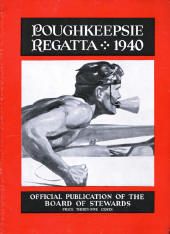 The
cover of the 1940 IRA program.
Thank you Archives and Special Collections at Marist.
Added
10/21
The
cover of the 1940 IRA program.
Thank you Archives and Special Collections at Marist.
Added
10/21
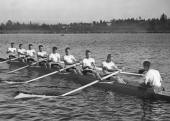 |
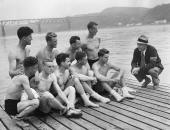 |
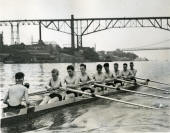 |
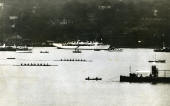 |
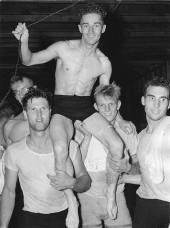 |
| Left to right, all photos from the Marist Collection (featuring hundreds of photos of the IRA's when the National Championship was held at Poughkeepsie) that is worth the visit here - The Poughkeepsie Regatta, 1891 - 1949: The UW Varsity in front of the shellhouse on the Cut prior to departure; the V8 with Coach Ulbrickson on the Poughkeepsie docks; the V8 out for a spin on the Hudson prior to the races; the Varsity as they cross the line as National Champions; and the men (John Bracken in back, Gerald Keely, Ted Garhart and Dallas Duppenthaler) hoisting coxswain Fred Colbert on their shoulders post-race as they head for the river. Thank you Archives and Special Collections at Marist. Added 10/21 |
||||
Washington alums - in 1940 all D1 collegiate rowing coaches - at the IRA's back row left to right: Chuck Logg '21 (Rutgers); Bud Raney '35 (UW Frosh Coach); Al Ulbrickson '26 (UW); Harrison "Stork" Sanford '26 (Cornell); Jim McMillin '37 (MIT); Norm Sonju '27 (Wisconsin); Tom Bolles '26 (Harvard); Rusty Callow '16 (Penn); Front row kneeling: Harvey Love '34 (Harvard Frosh); Ky Ebright '16 (Cal); Bob Moch '36 (MIT Frosh). Husky Crew Foundation. Added 10/21
![]()
1941
Ulbrickson knew what he had in '41 and was not afraid of pushing the men to meet his expectations. The men were hardly thrilled with it, as tough workouts and longer sessions became the norm even early in the year. By the spring however, the varsity had rowed one of the fastest 2000 meter time trials ever (the time to this day remains a mystery, as Ulbrickson would only say it was under six minutes).
The crew was ready to defend their Pacific Coast titles and did so in resounding fashion, breaking the Estuary course record in both the varsity and JV events. Both races were competitive, with California boating strong crews. The JV event was the best race of the day, with the crews together down the course, Washington separating at the end for a one length win. For the second year in a row, the California freshmen defeated the Husky yearlings.
On to Poughkeepsie two months later, Ulbrickson confident in his team. The JV race played out similarly as the Dual, except that the roles were reversed: California got ahead and stayed ahead, winning the Kennedy Cup for the first time in the school's history by about a length. The varsity race also played out similarly, only it was Washington with a repeat performance. The strength and endurance of Ulbrickson's '41 varsity was remarkable; they took a quick lead, Cal moved back to even by halfway - then Washington just pulled away. The crew won the Challenge Cup by two and a half lengths.
The 1941 varsity was one of the strongest ever boated by Ulbrickson. California had an excellent crew in 1941, and had to settle for second not once, but twice - and both times by open water. The New York Times sports section noted "Washington Wins IRA Regatta - Cornell wins Eastern Division" (1), a testament to the dominance west coast rowing held. In fact, since 1932, only Navy had snuck in a win (1938), between four Challenge Cup victories by Washington, and four by California.
It is unlikely the participants at the 1941 IRA could
have foreseen the impending events of 1941 that would forever change our nation.
Not much escaped change during the war years - in fact, the IRA, after being
cancelled in 1942, would return in 1947 with a new format. The four mile
varsity race was a casualty of those changes, and so the 1941 Washington varsity
also holds the distinction of being the last crew to win the four
mile collegiate IRA race.
A postcard view of Lake Washington Boulevard winding toward Andrews Bay and Seward Park in the early 40's. Husky Rowing Foundation Collection
The 1941 Varsity Boat Club Dance. The VBC dance was a prime occasion in the 30's and 40's, attracting large crowds, held in the Spanish Ballroom at the Olympic Hotel, and featuring top entertainment. The event was scheduled in early January, immediately preceding full-time training, and was attended by alums, friends, and - of course - the students. Here Dave Ross's Orchestra plays against the traditional backdrop of sweeps. Tyee photo.
John Bracken can't wait for training. From left
to right, Dance Chairman Vic Fomo (calling the power ten), Janet Griffin,
Mary Alice MacLeod, Ed Kerrihard, and Margaret Oswald. It was Don Hume,
the stroke of the '36 Olympic crew, that persuaded Fomo to turn out for crew.
A friend of Fomo's older brother and Anacortes High grad, Hume told the young
man he would make a great coxswain. Not planning on attending
college, Fomo says "I believed him", took and passed the entrance exam, and
ended up taking a different road through life. Tyee photo.
The varsity on the Estuary, rowing to a multiple length
win in 14:28, shaving 20 seconds off of the previous three-mile course record
(the record was partially wind and tide aided). Tyee photo.
The JV's score an upset win over the highly touted (and future IRA champion) Bears on the Estuary. Tyee photo.
The 1941 lightweight varsity, left to right (cox to
bow): Boney, Rutherford, Fellows, Overby, Vynne, Wilson, Sheerer, Dickison,
and Cartwright. The lightweight crew only had one race in 1941, losing to
a fine Sacramento Junior College on the Sacramento course by 1 and one-quarter
lengths. Tyee photo.
The class of '44, left to right: McGee, Bianchi, Schroeder, Cuykendall, May, Phillips, Dehn, Curkendall, Swisk (cox). The freshmen dropped their one race of the season to Cal on the Estuary by three-quarters length. Tyee photo.
The JV's, left to right: Soules, Jenkins, Erickson, Sauer, Thomas, Leinenweber, Dingwall, Galbraith, Kerrihard (cox). Tyee photo.
The varsity, left to right: John Bracken, Paul Simdars, Bill Neill, Doyle Fowler, Chuck Jackson, Walt Wallace, Tom Taylor, Ted Garhart, Vic Fomo (cox). Al Ulbrickson called this crew "as great a crew as I've ever had... I've never seen a gang with such sockeroo." The men were inducted into the Husky Hall of Fame in 1991, fifty years after dominating the National Championship. Tyee photo. Listen: Hear Vic Fomo describe what Husky Crew has meant to him: Vic Fomo '42 and Husky Crew (mp3 file, 2 minutes).
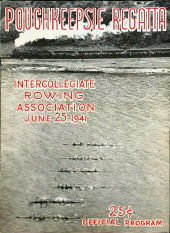 The
1941 IRA Program. Husky Rowing Foundation Collection
The
1941 IRA Program. Husky Rowing Foundation Collection
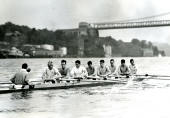 The
Varsity practicing on the Hudson.
Archives and Special Collections at Marist,
Added
10/21
The
Varsity practicing on the Hudson.
Archives and Special Collections at Marist,
Added
10/21
One of the best photos of the UW's Poughkeepsie Boathouse; every year the men would come back to this boathouse... what this historian would give to have some photos of the inside. But also a fantastic photo of the 1941 Varsity 8, without question one of the very best Washington crews of all time. Archives and Special Collections at Marist, Added 10/21
The finish of the JV race on the Hudson, with California leading and the Huskies finishing second. Tyee photo.
Captain Charles Jackson left, Al Ulbrickson middle, and Ted Garhart celebrate after the victory. Archives and Special Collections at Marist (right); Added 10/21
This is the bow flag of the Loyal Shoudy with
the signatures of each man in the crew. Fomo says of the 1941 race "There
wasn't any question we were going to win... we were so close together, and every
oarsman in that boat was just outstanding." Washington Rowing
Collection.
![]()
1942
The priorities on campus changed on December 7, 1941. Even so, as the young men prepared to enter the service, competition on the water remained intense. The veteran senior stroke Ted Garhart early in the season welcomed three newcomers into the varsity shell - Dave Roderick, Carl Schroeder, and Charles May - by turning around in his seat and saying "if you want to stay, you better get in shape - because we don't lose." (1)
California came north with another strong squad to row on the old Leschi to Madison Park course (the Sheridan Beach course was closed due to restrictions at the Sand Point Naval Air Station). This course, known for rough and windy conditions and famous for many earlier sinkings, was like glass on April 12th when the crews lined up.
The freshmen began the day by winning their two mile race by six lengths, defeating the Bears for the first time in three years. The JV's followed with one of the closest races ever recorded on the three-mile course, winning by scant feet and once again defeating a highly regarded Cal team. The varsity finished the sweep with a win over the strong Bears by three lengths. All three crews set new records for the course (last raced on in 1930), with the JV's most impressive, crushing the old record by thirty-one seconds and finishing about a second slower than the Varsity in their race.
With the 1942 IRA's cancelled, the season ended with the Dual. Had the races been held, it is likely that Cal and Washington would have fought it out once again. Both of these squads were strong and deep. As it was, most of the graduating class went on to serve in the military. Ted Garhart, on his way to becoming a marine corps officer in the South Pacific, won the 1943 Seattle P-I Man of the Year award. He, along with teammates John Bracken and Vic Fomo, never lost a race as Huskies.
Al Ulbrickson and freshman coach Bud Raney enjoying a lighter moment. Tyee photo.
The 1942 VBC Ball, with Paramount Pictures singer Evelyn Dinsmoor providing the entertainment. Per the Tyee: "Complying with the rule of no off-campus dances, chairman Jack Wilson took over the ROTC Armory. The Loyal Shoudy, the four years unbeaten racing shell, was part of the traditional nautical decorations. Crewmen turned all out for a final fling on the eve of training season." Tyee photo.
The freshmen stroking to a lop-sided win. Tyee photo.
One of the closest races ever on the
Lake Washington three-mile course,
the JV's inch out Cal at the line. The underdog Huskies were challenged
every foot of the three miles by their coxswain Keith (Paul) Brown, who answered
every move by Cal with a move of his own. (2) Tyee photo.
The varsity, long and strong as they approach the finish three lengths ahead of Cal. Tyee photo.
The 1942 varsity, left to right, bow to stern: John Bracken, Dave Roderick, Carl Schroeder, Doyle Fowler, Charles May, Walt Wallace, Tom Taylor, Ted Garhart, and Vic Fomo, cox. "Long" John Bracken, at 6'7" tall and weighing in at 170 lbs, was at home in the bow seat throughout his varsity career. Tyee photo.
The 1942 JV's, left to right, bow to stern: Pete Pederson, Andy Galbraith, Dave Boals, Doug Cuykendall, Hal Willits, Jack Phillips, Bill Dehn, Tom Curkendall, and Keith Brown (cox). Tyee photo.
The class of '45, left to right, bow to stern: Fred Mitchell, John Dresslar, Lindsey Herrell, Robert Taylor, Jack Ervin, Art Mortensen, Ernie Miller, Murray Haskell, Bob Payne (cox). Payne said what he remembers most about his days with the program "We had a fine bunch of guys - all of the guys on the team. What I remember most is the camaraderie and the friendships we made." Tyee photo.
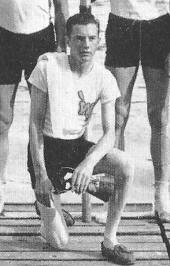 |
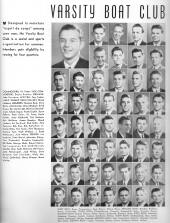 |
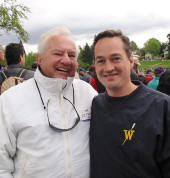 |
Vic Fomo 42, standout Washington coxswain, Varsity Boat Club Commodore, and UW Hall of Famer, passed away at the age of 94 on April 22nd, 2015. A three-time National Champion at Washington (Frosh, JV, and Varsity), Vic was a member of the 40 and 41 teams that dominated collegiate rowing and are still considered two of the strongest teams to ever row at Washington. Because the 1942 IRA was cancelled due to the outbreak of WWII, Vic was not able to complete the career sweep at Poughkeepsie. But the 42 varsity went undefeated on the coast, completing his tenure without ever losing a race. When I interviewed Vic for the history pages in 2003, his consistent message was how blessed he was to have been part of Washington Rowing. His teammates, and the program itself, were a big part of his life. That quality is made that much more significant when one takes into account the fact that these men the men of the 1940 team that dominated US rowing were very likely going to be the USA representatives at the 1940 Olympics; an Olympics that were first slated for Tokyo, then moved to Helsinki, but both ultimately cancelled days before the IRAs due to the events across the globe leading to WWII. But always upbeat, here is Vic talking about what Husky Crew meant to him: Listen: Hear Vic Fomo describe what Husky Crew has meant to him: Vic Fomo '42 and Husky Crew (mp3 file, 2 minutes). Even though his health was declining, Vic made the effort to be at many of the Washington races, including recent IRAs. Inducted into the Washington Hall of Fame in 1991, Vic remains one of the best coxswains to ever wear the W. Eric Cohen for Sweep Magazine, Summer Edition 2015 |
||
1) Interview with Vic Fomo 12/02; 2) "Way Enough", Recollections of a Life in Rowing; Stan Pocock; pg. 44.
![]()
1943
With the war raging in Europe and the Pacific, enrollment at the University dropped dramatically. Gone to war were virtually all of the men out of the varsity and JV boats from the previous year, as well as many of the other oarsmen at the boathouse. The varsity was so depleted that by the spring of '43, freshmen were rowing in the JV boat so that Ulbrickson could man two boats at practice.
Thus the crew only sent two boats south (on a packed military train) to race the Bears on the Estuary, the varsity and a freshmen eight. The varsity was mowed down early, ultimately losing the three-miler by eight lengths. The freshmen eked out a win by bare inches to avoid the sweep.
The men came back home to Seattle to continue their education and military training. That fall, with the rowing program now cancelled for the duration of the war, Al Ulbrickson accepted the position as Athletic Director at the University (for the ASUW).
The varsity posing in the Cut. Tyee photo.
The freshmen. Tyee photo.
The freshmen, near side, charging to the finish to win by inches on the Estuary. Tyee photo.
The class of '46, left to right, stern to bow: Jack Swanson, Bernard Benthin, Jim Edson, Myron Mitchell, Bob Fristroe, Loys Lamb, Jim Green, Don Mack, Bob Lee, (cox). Tyee photo.
The varsity, left to right, stern to bow: Elliott Loken, Hal Willits, Jack Dresslar, Jack Ervin, Art Mortensen, Ernie Miller, Wally Soli, Bill Dehn, Bob Payne, (cox). Tyee photo.
The 1943 lightweight first boat, left to right: Stan Pocock, Jack Kriebel, Jack Kelsall, Don Ostrom, Phil Boguch, Bob Hutton, Roger Rice, Bill Wickman, Jerry Luther (cox). The lightweights won both of their races of the season - both against UBC - one at home, and the other on the Fraser River in British Columbia. Tyee photo.
The affable and well-liked "Long" John Bracken died in a sailing accident on Lake Washington in 1942. Undefeated as a Husky, Bracken was a captain and soft-spoken leader. First freshmen crews in the seventies and early eighties rowed in the shell John Bracken - and true to the boat's namesake - many seasons went undefeated as a silent tribute to this exceptional Washington athlete. Tyee photo.
![]()
1944 - 45
Even with the rowing program cancelled, the boathouse remained open for intramural rowing, and also a military program. Three days a week, Captain Paul Moore, head of the Marine Corp attachment at the University and a veteran of the war (he was stateside after a brush with death at Guadalcanal), "coached" a group of men in the V12 program out on the lake.
Two races were organized in these years - one against a group of coast guardsmen who were handily defeated, and another against UBC, who defeated the men representing Washington by a few feet.
But the focus was clearly on the war. The V12 was an organized program set up by the government to train new Naval officers. Upon graduation, those officers would report to duty overseas. The crew races - in fact all sport at the time - was a brief, welcome distraction from the all-consuming effort to win the war.
Some of the V12 members on the dock of the boathouse. Tyee photo.
The 1944 Varsity Boat Club. Of those that were not already on active duty, training in the V12 was intense, demanding, and year-around. Tyee photo.
 |
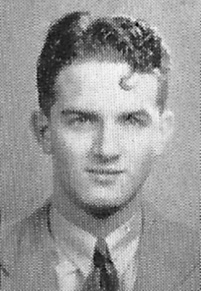 |
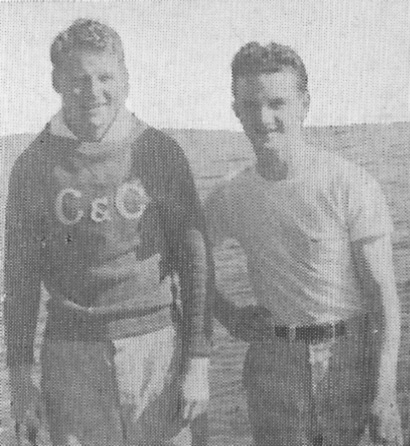 |
Gerald G. Luther, 1942 and 1943 Varsity Lightweight coxswain, was killed in
action on January 7th, 1945, less than a month after being deployed to the
French/German border with the 70th Infantry Division of the US Army (General
Patton's 3rd Army) in December of 1944. He was 22 when he lost his life.
Awarded the Purple Heart and Bronze Star for valor and heroism, Sergeant Luther, engaged in close combat with German soldiers and "utterly disregarding the hazard of exposing himself to heavy enemy 88mm (artillery) and small arms fire, skillfully led his squad from house to house, pushing forward until his mission was successfully completed," according to the Seattle Times article above. Two days later, he was killed saving three of his men from a grenade that landed in their foxhole.
Pictured above from the 1943 Tyee yearbook (also see the photo above of the 1943 first varsity lightweight team), and on the right with fellow coxswain Henry Meador in 1942, Luther was the top coxswain for the lightweights in both 1942 and 1943, and enlisted in the Army after graduation. He is buried in Plot D, Row 10, Grave 7, at the Lorraine American Cemetery in St. Avold, France. Tyee photos. Thank you Lee Corbin.
![]()
1946
With victory in Europe on May 8th, followed by victory over Japan on August 6th, 1945, WWII came to an end. By the winter of 1945 - 46, men were trickling back to campuses across the country under the GI Bill.
Meanwhile Al Ulbrickson, offered the AD job again, politely declined and went back to his passion, rowing, in the early spring of '46. Getting the boathouse back in condition was not easy, and it was not until March of 1946 that workouts began. Since most of those entering school had never held an oar, let alone sat in a shell, rowing was confined to Nero, and the wherries and barges. (1)
Down at Cal things were more serious. Once again, following in the wake of a forced hiatus due to war, a faction within the ASUC executive committee was bent on eliminating rowing. The reasons were complicated and yet they were not; since the beginning of intercollegiate rowing on the west coast there were those who were unhappy with the lack of revenue generated by the sport. It took quick action by a reinvigorated Ky Ebright to mobilize the students to maintain the program. Hence Cal also got a very late start on the season, boating crews in mid-spring. (2)
With no Dual race scheduled and the IRA's remaining mothballed, the veteran supporters of rowing (led by former coxswain Curly Harris) and the Chamber of Commerce in Seattle began to talk about an all-comers regatta on Lake Washington. Through a fund raising drive that netted about $50,000, the hastily organized regatta attracted tens of thousands of spectators (some estimates put it at 100,000) to the shores of Lake Washington on June 22, 1946.
Entries included Washington, California, Harvard, Wisconsin, MIT, Cornell, Rutgers, and UBC. The course was 2000 meters, starting south of the floating bridge and finishing in the protected waters of Andrews Bay at the isthmus of Seward Park. On a windy day, Cornell won the race, with MIT second and Washington third. The boats furthest outside were awash in white caps early in the race and took on a lot of water, but that would be the least of their problems. After the regatta, as the countless watercraft went home, the combined wakes created a chaos of wash that sank every shell on the water. Every oarsman and coxswain swam that day, and only through the extraordinary effort of some boaters was no one injured.
Sunk crews or not, the final analysis of the regatta was a resounding success. It reinvigorated the community and created a national stir. Yes, it was very different from the IRA - shorter and on the opposite coast. But it was a good metaphor for the times. Sporting events could be enjoyed again. And things were different now - not yet definable, but different.
Time magazine covers this race noting the Conibear coaching legacies that
came to Seattle that year -
TIME
Magazine Archive Article -- A Sweep for Conibear -- Jul. 01, 1946
A post-war Seattle, with Pike Place Market in the morning. Postcard photo
An afternoon out on the water. Tyee photo.
The 1946 varsity, with the starboards to the starboard
side of coxswain Bob Payne, and the ports to his port side (left to right):
Bob McFarlane, Dave Thompson, John Anderson, Jim Tupper, Bob Payne (cox), Grant
Bishop, Jim Horsley, Bill Works, Ted Gibson. Tyee photo.
Nero was the boat of choice in March and April for Ulbrickson. It had been three years since formal turnouts at the boathouse and there were a lot of new faces - and a lot of remedial rowing required for the old faces. Tyee photo.
The crew managers of 1946: freshmen managers front row
left to right: Chuck Degginger, John Mucklestone, Roland Dick, Jack Gwinn,
Ed Natchwey, Mitchell Montchalin, Joel Toothacker. Upperclass managers
back row left to right: Bill Brooks, Bob Blancher, Phil Runkel, Bill
Torrance, Bill Ellison, Bob Myer, Bruce Walter (senior manager). Tyee photo.
Cornell moving into the lead as the crews pass the thousands lined up on the
shores of Lake Washington. Photo: Robert Ball,'41 as scanned by his son,
Joseph Ball in 2007.
Entering the last 300 meters, looking across to the isthmus of Seward Park.
Photo: Robert Ball,'41 as
scanned by his son, Joseph Ball in 2007.
The event included a flyover, entertaining the crowds much like the Blue
Angels do today at the Hydroplane races; this rowing course actually
crossed through the current hydroplane course on Lake Washington. Note the
crowd and the yachts lined up down the course, and imagine rowing through those
wakes on your way back to the launching area. Photo: Robert Ball,'41 as
scanned by his son, Joseph Ball in 2007.
1) Masters Thesis: The History of Intercollegiate Rowing at the University of Washington through 1963, Al Ulbrickson Jr., pgs. 152-153; (2) The Log of Rowing at the University of California, 1870-1987; Jim Lemmon; pg. 36.
![]()
1947
By the fall of 1946, young men fresh from the service were now flocking to universities across the country on the GI Bill. Similar to the years immediately following WWI, the "freshmen" entering the University were older, more physically mature, had recently experienced war first hand, and had returned home as heroes. A passion for life and a sense of great achievement bred a confidence rarely seen in whole generations. This generation now had it.
The freshmen turnout outnumbered the varsity, and in that turnout were some imposing figures. So imposing in fact that by March the first freshmen boat was consistently beating not just the JV eight but the varsity as well. This trend would continue for the remainder of the year.
Cal came north for the first time since 1942 to resume the Dual on Lake Washington in April on the new Andrews Bay course, the course starting at the floating bridge and ending at Seward Park, a distance of about two and three-quarter miles (the freshmen race was two miles). The freshmen dominated their race from start to finish, and the JV's won as well, coming back after a poor start to win by open water. The varsity started well and gradually drew out to a commanding open water lead. At about the two mile mark, the Washington stroke rate began to drop, and despite the pleadings of coxswain Bob Lee, the rate fell from a 32 to a 30, to a 28, and finally to 24 strokes per minute. California, maintaining a race stroke, passed the Huskies with about 100m to go, flying by a Washington varsity that drifted across the finish line. Ulbrickson attributed the loss to heat exhaustion in the unseasonably warm weather of a hot April day, with two men (including captain Bill Works) taken out of shells, one rushed to the hospital.
With the IRA's scheduled for the first time since 1941, the crew looked for revenge. The varsity and JV traveled by rail first class (the first and only recorded time) thanks to the influence of Gordon Callow, following in his Dad's footsteps as ASUW president. (1) The freshmen, left behind to finish class work, became the first Washington crew to travel by air, joining their teammates at Poughkeepsie.
On race day, the powerful freshmen never lost a beat, driving home a multiple length winner in the Steward's Cup. The JV's, having swapped out their stern pair for the varsity stern pair, fell to a re-made Cal JV; Ebright had taken five of his best frosh (Cal was a beneficiary of the GI Bill as well), combined them with three JV members, and produced a very fast hybrid JV boat at the IRA. The varsity, never able to gain the confidence critical to fast crews, fell to a fine Navy crew on the new three mile course, finishing third behind Cornell (but fulfilling Ulbrickson's prediction that the varsity would beat Cal at Poughkeepsie) (2).
At the Loyal Shoudy banquet that followed the races, Ulbrickson also announced that he would race the undefeated freshmen as his varsity in the second annual Seattle Sprint race scheduled one week later (this was based on a six minute time trial he had run on the Hudson with all three crews, the freshmen once again coming out on top). On a special early run of the new Great Northern Railroad's Olympian Hiawatha, eleven university crews got aboard in New York and went west together to race 2000 meters on Lake Washington (1).
With the full armada and a crowd now estimated at over 150,000, Lake Washington was a jewel on June 28th, 1947. With a north wind helping push the crews down the course, Yale jumped to a quick lead, with Cornell, Washington, Harvard, and Penn forming the lead group. At 1000m, Harvard powered to draw even with Yale, and at 1500 meters Washington began to move. On the sprint, Harvard moved ahead, followed by Yale and a now closing Washington crew. Harvard won in the fastest recorded 2000m race to date in 5:49.1, followed by Yale about a length back and Washington a deck shy of Yale.
It was a spectacular way to end a not so spectacular season. Eight freshmen earned varsity letters that day. The writing was on the wall for Ulbrickson - not since the classes of '37 and '41 did he have such a talented and deep group of freshmen.
And the long Olympic drought was finally over. Twelve years was a long time to wait - for every rowing program in the nation. But maybe even longer for Ulbrickson, who swallowed the bitter pill of watching the Olympics cancelled days before the 1940 trials, with his undefeated national champion varsity that year chomping at the bit. What a waste that was, and what an opportunity was at hand.
Ulbrickson addresses a huge group of men returning from the war on the G.I. Bill. The 1946 fall turnout was one of the largest on record. Tyee photo.
Ulbrickson back at the helm for the first full season following the war. Tyee photo.
Coaching down the Cut. Tyee photo.
On the lake, preparing for California. Jim
Tupper, seven man of the varsity remembers the California race vividly:
"The day was getting hotter and hotter. It was a good day though - we were
understroking them and were out in front. (Near the end, as the stroke
rate began to drop)... the first thing I noticed was, as I finished my stroke
(and recovered), there was Grant's (Bishop, the stroke) back. It was like
somebody was taking the finish line and moving it away from us." With
Bishop unable to maintain a rhythm, the boat came to a virtual standstill,
coasting across the finish with Bishop collapsing into Tupper's lap. "Push
me up Jim" - recalls Tupper of Bishop's request - "I want to look around".
Then he collapsed again. Tyee photo.
This page, from inside the program, shows the 2000m course as it was measured for the Seward Park (Andrews Bay) section of the lake. Preceding the 12-across, winner take all Varsity race at 4:30 pm (finishing in Seward Park), would be the National Junior Mile Swimming Championship at 12:45; sailboat and outboard racing at 1:30; an air show by the Navy Reserve with water skiing and log rolling contests at 2:00 pm, Indian War Canoe racing at 2:45, and the four-oared Pickle Boat race (where spares from all of the teams were drawn out of a hat to make the boatings) at 4:00 pm. Husky Crew Foundation photo: Erickson collection.
One of the earliest color newsreels with ten minutes of amazing rowing footage from the 1947 regatta in Seattle, including introductions of the coaches (most of them former UW rowers, see below), George Pocock, rows of cedar shells, the Olympian Hiawatha (most of the teams came west immediately following the IRA in Poughkeepsie on the same train), and, of course, the race. According to the newsreel, 200,000 fans were there on a perfect summer day in Seattle; the shots of the crowd would back that up. Take a step back in time and watch this... this is real history as it happened. Thank you Jon Biglow for posting; added 10/22 |
The Seattle Times celebrating the dominating reality of collegiate rowing: the vast majority of the leading rowing teams in the country were all coached by ex-Washington rowers and coxswains, referenced (not entirely without derision) in private rowing circles as the "Washington Mafia". Royal Brougham, writing in the Seattle P-I, said, "Old Washington oarsmen with moist eyes will look on the scene today and tell one another - 'If old Connie could only see the spectacle for which he used to hope!'... rowing was just a dream in Hiram Conibear's eye when the old White Sox ex-trainer came to Washington, and today eight of the twelve crews are coached by Connie's rowing sons..." The Seattle Times via the Rosenbaum Collection. Added 10/21
The 1947 freshmen: National IRA Champions and the Varsity boat (minus Bill Wall) in the Lake Washington Regatta. Left to right: Manford McNeil, Bill Wall, Bob Young, Dave Dixon, Norm Buvick, Bob Harris, Rod Johnson, Warren Westlund, and coxswain Al Morgan. Tyee photo.
An aerial view of the regatta, with Harvard leading, Yale second, and Washington a quickly closing third (they finished .10 second behind Yale). Tyee photo.
The finish. Bill Works, the
27 year-old senior captain of the
varsity squad, rowed four-seat in the Washington crew that placed third.
The rest were freshmen: Westlund, Johnson, Harris, Buvick, Young, Dixon,
McNeil, and cox Morgan. The class of '50 - freshmen in 1947 - are the only
crew to go undefeated on Class Day (won all four years) and are among the very,
very few who also lettered all four years. After
the race Al Ulbrickson said, "I congratulate everyone in the boat and give great
credit to Bud Raney, the freshmen coach who developed a National Championship
freshman outfit at Poughkeepsie and a heroic Varsity line-up today." Tyee photo.
Grant Bishop was the stroke of the varsity in the 1947 Dual. A strong, determined oarsman, he had silently endured serious abdominal pain all year that was attributed to ulcers. It was not ulcers. After the racing season, he was diagnosed with cancer. That summer, he took his own life. Jim Tupper said of Grant: "He was my buddy. He was my hero." Tyee photo.
Bud Raney, freshmen coach from 1937 to 1947, left in the summer of '47 to accept the head coaching job at Columbia. His Washington freshmen crews went to the IRA's four times during his tenure, winning the Steward's Cup three times and finishing second once. During the war, he served in the Navy. Tyee photo.
Frank Cunningham was a fixture in northwest rowing for 50+ years, a high-character, highly knowledgeable coach and mentor for thousands of athletes of all ages. This screenshot, from a video in Seattle in 1983 with US National Team Scullers (including Paul Enquist and Brad Lewis - who would go on to win gold in the M2X at the 1984 Olympics: Row2k.com - Dick-Erickson--Frank-Cunningham--Harry-Parker coaching: 1983), captures Frank at his iconic best. A master of technique, a perfectionist in many ways but also a pragmatist, he said, "To learn the quickness and spontaneity that characterizes good sculling, spend some time watching animals. From them you can learn the grace that comes from their economy of movement and their complete reliance on their senses." (3). So why does Frank Cunningham make the Washington Rowing History in 1947? Well, besides the fact he coached and became friends with many Washington rowers and coaches throughout the decades, Frank was sitting in the stroke seat of the 1947 Harvard Varsity 8 that won the Lake Washington Regatta in world record time, and he did it as one of the smallest oarsmen in the competition. That is how tough he was, and how exceptional he was as a rower... and also... it was partially that experience that brought him back from the east coast to the Seattle area to permanently make his mark on the sport here. Inducted into the US Rowing Hall of Fame and a recipient of US Rowing's Medal of Honor, Frank Cunningham remains one of the single most important influences on rowing in the Northwest.
"Way Enough", Recollections of a Life in Rowing; Stan Pocock; pg. 22-23; (2) Masters Thesis: The History of Intercollegiate Rowing at the University of Washington through 1963, Al Ulbrickson Jr., pg. 153-155; (3) Seattle Rowing Icon Frank Cunningham Dies at 91, Craig Smith at the Seattle Times; March 8, 2013
![]()
1948
With Bud Raney leaving for Columbia, Gosta "Gus" Eriksen and Stan Pocock assumed the assistant coaching positions in the fall of 1947, Eriksen coaching the freshmen, and Pocock the lightweights. Eriksen, already a rowing legend from the thirties and previously the skiing and swimming coach at the University, had at least 200 freshmen turning out in the fall.
The varsity was equally as deep - young, but deep. As the winter gave way to the spring the crews became intensely competitive, an environment that Ulbrickson, over the years, had consistently fostered. Unfortunately, by the end of the year, he had a JV and Varsity crew that would not talk to each other.
But the results on the water on May 22nd would speak volumes for the talent on this team. On the Estuary, the freshmen began the day with a two length win over the Bears; the JV's followed up with a three length win; the varsity finished the day with a three length win. In all three races Cal took the early lead, and in the JV and Varsity events were ahead through the mile and a quarter mark, before Washington's strength and endurance carried the crews past their competition.
About a week later on Lake Washington, the Huskies earned multiple length victories over a visiting Wisconsin JV and varsity crew. With that tune-up the men headed east for the Hudson.
On June 22nd, the freshmen again led the charge at the IRA's with a resounding victory in the Steward's Cup. After a boat stopping crab in the first ten strokes, the crew settled down to overtake every other crew in the race, finally driving past the favored Navy crew to win going away by two lengths. The strong JV's, favored to win, did so from start to finish, winning by three lengths. The varsity started well and settled to a 32, then mid-race began to move through the leaders. They passed the final crew, Navy, at two miles and finished the race in a sprint to win by two lengths, completing the third sweep for the Huskies at the IRA (the two previous were '36 and '37).
The next week was spent at Lake Carnegie quickly re-training for the 2000m Olympic trials. Both the varsity eight and the stern four of the JV eight went to Princeton to race, with the varsity heavily favored based on their undefeated season. In their first heat, the varsity defeated MIT and Wisconsin handily, moving to the semi-final against Cal.
On July 2nd, the varsity lined up against Cal. Cal had stayed with Washington in the first mile of each previous three-mile race, so the Huskies knew the crew had early strength. What they did not know is Cal felt convinced they could win this race based on a sub-par performance at the IRA. Cal took an early lead in the race, with Washington staying within reach, but with 500m to go Washington was behind by 3/4 length. A furious finishing sprint brought the crew back rapidly, but California won by a stunning three feet.
On July 10th, the Husky 4+ bested eleven other entrants at the Trials to become the U.S. representative in the fours competition. The crew sailed to London without Al Ulbrickson; he had declined the invitation to be small boats coach, ceding the job to George Pocock, who was already slated as rigger for the team. The SS America was equipped on deck with four ergometers, which the athletes shared with their new California teammates daily.
The course was at Henley. There were over 200 other crews and boats there practicing for the multiple Olympic events, and it was crowded. No launches were permitted on the course, meaning coaches on bicycles, speaking countless languages, competed for space on a three-foot wide path. Pocock, the former English sculling champion born and raised on the Thames near Eton, knew where they needed to go; eight miles down the river was a boathouse at Marlow with four miles of open water for training - and no limitations on launches. Ky Ebright did not hesitate: the two found a launch, the crews rowed the eight miles (and two locks) down the river, and there the California eight and the Washington four trained for an intense and private week as teammates.
The four began competition by defeating Finland by two lengths to advance into one of the three semis; but due to the narrowness of the Henley course, only the winner of the semis would advance to the final. In a narrow and shaky win over France that same afternoon (high stroking the first half and almost running out of gas at the finish), they won their semi to row in the medal final. Two days later, on Monday, August 9, 1948, the team lined up on the "Berks" (club) side of the river, with Switzerland to their right and Denmark a lane over from there. The men knew the other crews would jump ahead; but this time, sticking to their Pocock race plan for swing and patience (and understroking the competition), by midway through the Thames course they had pulled even with the excellent Danish squad; by 500 meters to go, the five young men from Seattle had taken the lead. In a powerful sprint - with plenty left in the tank this time around - the Husky 4+ finished two lengths ahead of second place Switzerland to win the Olympic gold, Denmark finishing third.
Later that day, California won the third Olympic gold medal of Ky Ebright's career in the eights competition. The eight and the four were the only U.S. crews that won gold that day (the rest did not medal except the four without coxswain, which won bronze).
1948 was a watershed year for rowing at Washington. The gold medal in the four would bring on the support needed to build a new, state of the art rowing facility at Washington. The IRA sweep was a monumental achievement of Ulbrickson and his staff, and the publicity surrounding this golden year would resonate for years in Seattle.
Yet history would suggest that it was also a turning point in Ulbrickson's career. The loss at the trials of the eight, most observers would agree, was crushing. For his highly favored and undefeated crew to lose to Ky Ebright - a man he respected as his ultimate competitor - made it worse. By three feet. The man of few words became the man of no words.
Meanwhile, the post-war economy was booming.
University athletic budgets were growing. Ulbrickson, at his summer home
on Orcas Island, was preparing for the next season. And although the coach
would continue on for another ten years and savor the glory of victory on
international waters again, 1948 remains a season that marks a turning point for the
program. A new era in Washington rowing - and collegiate rowing - was beginning.
The University of Washington campus in 1948. Husky Rowing Foundation photo. Added 10/21
The lightweight varsity, left to right: Schoening, Lee, Wichman, Lynch, Hofto, Olsen (R), Olsen (E), Brett, and Knapp (cox). Tyee photo.
The lightweights defeating James Bay BC by open water
at Victoria B.C. Tyee photo.
The Class of '51 freshmen, left to right, stern to bow: Baird, Brockman, Anderson, Joss, Graham, Brown, Johnson, Lundgren, and Griffen (Tren), cox. Tyee photo.
The junior varsity on the Cut in spring, '48. Tyee photo.
The 1948 undefeated JV8 (UW/Cal
Dual line-up) left to
right: Fred Mitchell (bow), Bill Wall, Philo Lund, Dave Dixon, Gordon (Gus) Giovanelli, Bob Will, Bob Martin, Warren Westlund, with coxswain Al Morgan in
front. HRF photo
Added 9/22
The 1948 National Champion Varsity 8 on the Cut: coxswain: Bob Lee; stroke-Charlie McCarthy, 7-Rod Johnson, 6-Don Landon, 5-Norm Buvick, 4-Bill Works, 3-Bob Young, 2-John Audett, bow- Ed Hearing. Tyee photo.
A come from behind victory on the Estuary by the varsity. Tyee photo.
The Washington varsity defeating Wisconsin on Lake Washington May 31st. Tyee photo.
The JV's at the train station on their way to Poughkeepsie, a team as purely committed to each other as they come. Left to right: Bob Will, Charlie Brown (with ukulele), Al Morgan, Philo Lund, Warren Westlund, Bob Fletcher and Gus Giovanelli; kneeling are Fred Mitchell and Bob Martin. HRF photo Added 9/22
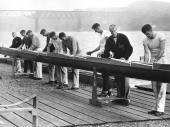 |
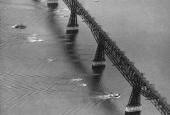 |
 |
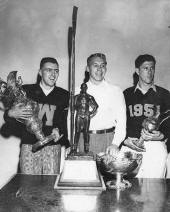 |
Photos from the Marist Collection (The Poughkeepsie Regatta 1891-1949: 1948) left to right: The UW Varsity rigging their shell on the Poughkeepsie docks; under the railroad bridge and leading; and across the line with open water. Far right Tyee photo: the stroke oars of the UW National Champion crews left to right: Charlie McCarthy, V8; Warren Westlund, JV8; Roger Baird, Frosh 8, along with "The Oarsman" Trophy signifying the IRA Team Championship. Added 9/22 |
|||
Established in 1947, "The Oarsman" trophy went to the highest placing team across all events. This is actually a page from the 1949 IRA program but it belongs here in 1948, as 1948 would be the first official year the UW won this award. In fact Washington would win this trophy for the remainder of it's short tenure as the Team National Championship award, replaced when the IRA moved to Syracuse in 1952 with the Ten Eyck Trophy (still awarded today). But for 1948, 1949, 1950, and 1951... this trophy was dominated by Washington. HRF photo.
The 1st freshmen boat on Lake Washington. Tren
Griffin, at the end of the IRA race, noticed blood in the bottom of the boat;
come to find out Ken Brockman had sliced his leg so severely when he jumped his
slide during the first strokes that he would require stitches to close up the
wound. Tyee photo.
The varsity winning the IRA National
Championship to go undefeated for the year heading into the Olympic Trials. Tyee photo.
The California Varsity 8 was a crew that in the two previous three-mile races in 1948 had led the Huskies through the mile mark, but had lost the duration due to the endurance of the Washington team. At the Olympic Trials Cal used that quick start to jump to an early lead, and through a combination of preparation, coaching (Ebright), and grit held off a furious sprint by the Huskies to win by about three feet. The heavily favored Washington team was inconsolable; George Pocock, in a letter home to his wife following the loss, began the letter "... and now let us sit and talk of the death of kings" (1). Just as victories had shaped the program in years past, so too would this defeat. Tyee photo.
The stern four of the undefeated UW JV 8 and now the 1948 Olympic U.S.A. Four w/Coxswain, standing in front of the Princeton boathouse after winning the 4+ Trials on July 10th, 1948, left to right: Gus Giovanelli, Bob Will, Bob Martin, Warren Westlund, and coxswain Al Morgan. Photo from the Bob Martin collection - thank you David Koste.
 The four at Henley in the Clipper Too (named as
such because it was built as a sister ship to the Husky Clipper prior to
the '36 Olympics (1) ) with about 300 meters to go to win
the Olympic gold. Tyee photo.
The four at Henley in the Clipper Too (named as
such because it was built as a sister ship to the Husky Clipper prior to
the '36 Olympics (1) ) with about 300 meters to go to win
the Olympic gold. Tyee photo.
Washington pulling ahead on the Henley course in the gold-medal Final. Photo from the Bob Martin collection - thank you David Koste.
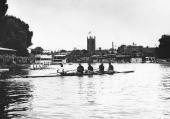 After
the finish, and waiting to arrive at the medal dock. Photo from the Bob Martin collection - thank you David Koste.
After
the finish, and waiting to arrive at the medal dock. Photo from the Bob Martin collection - thank you David Koste.
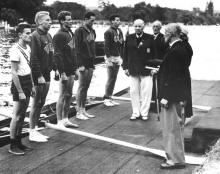 The
medal ceremony, standing as the American Flag is raised. The men reported later that they were so
tired after this race that standing upright for the National Anthem was not
easy. Photo from the Bob Martin collection - thank you David Koste.
The
medal ceremony, standing as the American Flag is raised. The men reported later that they were so
tired after this race that standing upright for the National Anthem was not
easy. Photo from the Bob Martin collection - thank you David Koste.
Surrounded by fans, the men head for the river with their coxswain. HRF photo
Al Morgan with the best swim of his life, hitting the Thames as Olympic Champion. HRF photo
Way Enough", Recollections of a Life in Rowing; Stan Pocock; pg. 43.
![]()
1949
The season started in October for the men, with another huge turnout of freshmen for Gus Eriksen and a slew of experienced, champion oarsmen returning to Ulbrickson. With the Olympic results and IRA victories still fresh in the mind of everyone surrounding the program, turnouts were spirited.
Meanwhile, Curly Harris, former coxswain and booster (he was the main force behind the '46 and '47 Seattle regattas, and served as the Director of the Alumni Association from 1936 to 1964) was busy in Olympia selling the legislature on a new crewhouse. Placed into an appropriations bill and receiving broad support, the University was provided $365,000 to build a new facility for the team - Conibear Shellhouse. The plan included a large shop for George Pocock, dining facilities for the team, a large lounge area, and space for 42 shells (the dormitory rooms on both wings were added in 1965). By the spring of 1949 the building was under construction. By the fall, it was nearing completion. From proposal to reality - from funding to design to completion - took about twelve months.
The idea of having one central location for the team was a dream come true - going back to the Conibear days. The VBC had not rented out a house since prior to the war, so the opportunity to live together was new to this generation and overdue. Once ground was broken in the spring, the prospect of this new building boosted morale that much more. And morale was important, since miserable weather in the spring of '49 had prevented the crews from ever getting in a three mile time trial.
California came north on a beautiful spring day. Eriksen's freshmen once again defeated their rivals, but the JV's were whipped by California. The varsity was confident, and cruised out to a length lead on the Seward Park 2.75 mile course. Cruising down the course and in command of the race with about ten strokes to go, a starboard oar caught a crab, and in prying it out jammed the shell to port where the entire port side crabbed. The shell turned perpendicular to the course. California just rowed on by.
Bent on revenge, the crews focused on the IRA. Stopping at Madison on the way east, the crews defeated Wisconsin, with a vastly improved JV squad winning by seven lengths over their Badger foes. In fact, by the time the crews had reached Poughkeepsie, Ulbrickson had (again) decided to pit his two upper class crews against each other for the right to row in the varsity race. The varsity boat prevailed, but not without a fierce challenge from the JV squad.
The 1949 IRA regatta would be the last one ever held at Poughkeepsie. The race, due to the rapidly gaining popularity of rowing, was simply outgrowing the venue. Furthermore, there was no shortage of other cities interested in hosting a national championship regatta. The current, the tides, the wind and weather - all of these were tolerable when there were six or eight crews lined up; but in 1949, there were twelve boats across the river in the Challenge Cup. Who had the best current? What about the wind? Add to those questions the rapid and dramatic post-war changes transforming the country, and the prevailing sentiment was that it was time for change.
So, true to form, race day turned ugly. In a downpour so heavy the crews disappeared from sight, all of the freshmen contestants had to row back to the docks to empty the rainwater from their shells. Once back on the water and started, the damp Huskies jumped to an early lead and never relinquished, winning by a half length of open water over Cornell.
Not unlike previous events on the Hudson, the JV race was subsequently postponed to get in the varsity race before dusk. With dark clouds hanging over the course and lightning striking all around (a strike hit the bridge a half mile from the finish during the race), the twelve crews fought down the river, with California prevailing over the Huskies by a half length.
In the following JV race, amid the gathering darkness, a false start created such confusion that Washington and Penn, fighting neck and neck, did not stop until over a mile into the race. Once restarted, Washington jumped out quickly and Penn had no answer, falling to fourth as the Huskies won going away by three lengths.
That summer, the team would begin the move out of the
old Navy hangar that had served as home since Ed
Leader had taken over the crew from his mentor, Hiram Conibear back in 1919.
They took with them the Kennedy Cup and the Stewards Cup to go in the new trophy
case - and left room for the coveted piece of hardware that had alluded them in
the gloom of Poughkeepsie.
Life magazine, the highly popular photojournalism magazine of it's time, published an extensive article on the Washington rowing team on June 20th, 1949. Google has since archived the 18 photos from this article and they can be found here - Washington Rowing Source: LIFE. Photos featured include an erg from the era, Al Ulbrickson coaching in Old Nero while a novice oarsman catches an over-the-head crab (eliciting grins from his teammates), photos of the crews training and at the shellhouse. Thank you Bob Koch '79 for the link.
Turnout. Tyee photo.
A lighter moment for the coaching staff, left to right Eriksen, Ulbrickson, and Pocock. Tyee photo.
Afternoon turnout on the lake. Tyee photo.
Ulbrickson shouting instructions from the Conny. Tyee photo.
Ulbrickson striking the "crew coach" pose in his office while talking with the guys. Tyee photo.
The varsity defeating Wisconsin on Lake Mendota on their way to Poughkeepsie. Tyee photo.
The program from the 1949 IRA Regatta, the last IRA to be held at Poughkeepsie. Guy Harper Collection.
![]()
The 1949 IRA, a global event reflected by this newsreel coming from Argentina (and in Spanish). Some excellent footage of the off-water life at Poughkeepsie, including the dining hall (and Warren Westlund '50 eating dinner...) and sleeping porches. Washington would win the JV and Frosh events in '49, but lost the varsity race to Cal, setting up the sweep of the river by Washington the following year in 1950. Thank you Bob Koch for sending in the link! (added 1/20/15) |
![]()
The JV's, left to right, stern to bow: Roger Baird, Wilbur Lowe, Ken Walters, Gordon Giovanelli, Roy Putnam, Don Brietenberg, Warren Westlund, Hal Brown, and cox Tren Griffin. Tyee photo.
The class of '52, left to right, stern to bow: Charlie Anderson, John Fletcher, Al Ulbrickson, Dick Jordan, Warren Helgerson, Carl Lovsted, George Waiss, Howard Kellogg, Dick Boyce, cox. Tyee photo.
The lightweight varsity, left to right, bow to stern: Duwain McBride, Ed Olson, Jim Art, Jack Russ, John Therrian, Tom Naden, Bob Wichman, Earl Jenner, cox. Tyee photo.
Conibear Shellhouse around completion, in the fall of 1949. Note the absence of docks (it will become an issue). Tyee photo.
Some of the guys posing on the deck of the new crewhouse. Tyee photo.
An aerial shot of the new building. What you
don't see in this picture is the massive, active landfill (garbage dump)
directly to the north and east of the crewhouse. The dump was filled over
in the sixties; prior to that, on a warm day with a north wind, look out.
And on any day, the rats. Tyee photo.
![]()
Sources for the 40's: University of Washington, The Tyee, 1941 -1950; VBC Log Book, 1936-1955, MSCUA; The Log of Rowing at the University of California, 1870-1987, Jim Lemmon; Ready All! George Yeoman Pocock and Crew Racing, Gordon Newell; "Way Enough", Recollections of a Life in Rowing; Stan Pocock; Masters Thesis: The History of Intercollegiate Rowing at the University of Washington through 1963, Al Ulbrickson Jr.; The Seattle Post Intelligencer, various articles (specifics available on request); The Seattle Daily Times, various articles (specifics available on request); A Short History of American Rowing, Thomas Mendenhall; Interviews with Ted Alderson, Vic Fomo, Bob Payne, and Jim Tupper, 12/02.
![]()
| Home | Contact Us | © 2001 - 2023 Washington Rowing Foundation |